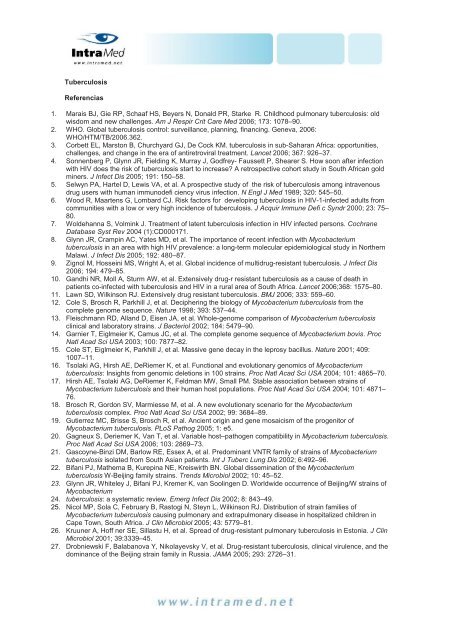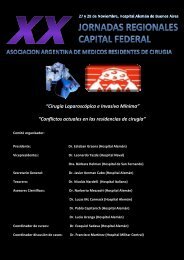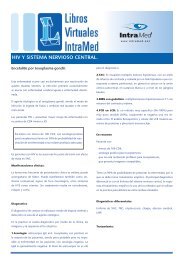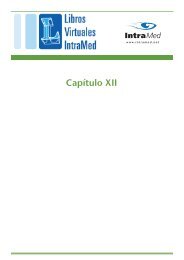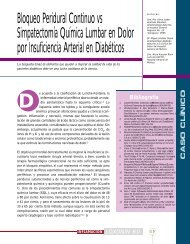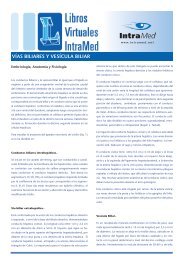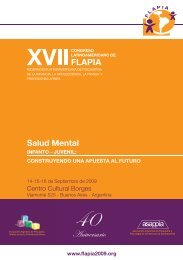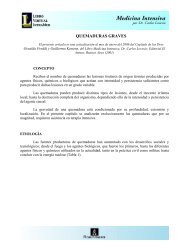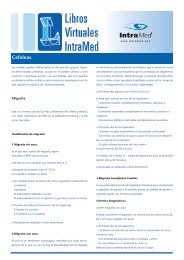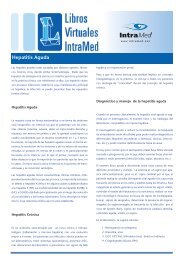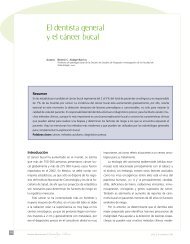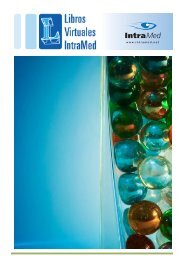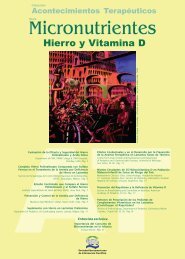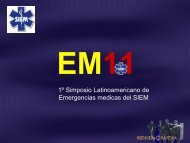Tuberculosis Referencias 1. Marais BJ, Gie RP, Schaaf ... - IntraMed
Tuberculosis Referencias 1. Marais BJ, Gie RP, Schaaf ... - IntraMed
Tuberculosis Referencias 1. Marais BJ, Gie RP, Schaaf ... - IntraMed
Create successful ePaper yourself
Turn your PDF publications into a flip-book with our unique Google optimized e-Paper software.
<strong>Tuberculosis</strong><br />
<strong>Referencias</strong><br />
<strong>1.</strong> <strong>Marais</strong> <strong>BJ</strong>, <strong>Gie</strong> <strong>RP</strong>, <strong>Schaaf</strong> HS, Beyers N, Donald PR, Starke R. Childhood pulmonary tuberculosis: old<br />
wisdom and new challenges. Am J Respir Crit Care Med 2006; 173: 1078–90.<br />
2. WHO. Global tuberculosis control: surveillance, planning, financing. Geneva, 2006:<br />
WHO/HTM/TB/2006.362.<br />
3. Corbett EL, Marston B, Churchyard GJ, De Cock KM. tuberculosis in sub-Saharan Africa: opportunities,<br />
challenges, and change in the era of antiretroviral treatment. Lancet 2006; 367: 926–37.<br />
4. Sonnenberg P, Glynn JR, Fielding K, Murray J, Godfrey- Faussett P, Shearer S. How soon after infection<br />
with HIV does the risk of tuberculosis start to increase? A retrospective cohort study in South African gold<br />
miners. J Infect Dis 2005; 191: 150–58.<br />
5. Selwyn PA, Hartel D, Lewis VA, et al. A prospective study of the risk of tuberculosis among intravenous<br />
drug users with human immunodefi ciency virus infection. N Engl J Med 1989; 320: 545–50.<br />
6. Wood R, Maartens G, Lombard CJ. Risk factors for developing tuberculosis in HIV-1-infected adults from<br />
communities with a low or very high incidence of tuberculosis. J Acquir Immune Defi c Syndr 2000; 23: 75–<br />
80.<br />
7. Woldehanna S, Volmink J. Treatment of latent tuberculosis infection in HIV infected persons. Cochrane<br />
Database Syst Rev 2004 (1):CD00017<strong>1.</strong><br />
8. Glynn JR, Crampin AC, Yates MD, et al. The importance of recent infection with Mycobacterium<br />
tuberculosis in an area with high HIV prevalence: a long-term molecular epidemiological study in Northern<br />
Malawi. J Infect Dis 2005; 192: 480–87.<br />
9. Zignol M, Hosseini MS, Wright A, et al. Global incidence of multidrug-resistant tuberculosis. J Infect Dis<br />
2006; 194: 479–85.<br />
10. Gandhi NR, Moll A, Sturm AW, et al. Extensively drug-r resistant tuberculosis as a cause of death in<br />
patients co-infected with tuberculosis and HIV in a rural area of South Africa. Lancet 2006;368: 1575–80.<br />
1<strong>1.</strong> Lawn SD, Wilkinson RJ. Extensively drug resistant tuberculosis. BMJ 2006; 333: 559–60.<br />
12. Cole S, Brosch R, Parkhill J, et al. Deciphering the biology of Mycobacterium tuberculosis from the<br />
complete genome sequence. Nature 1998; 393: 537–44.<br />
13. Fleischmann RD, Alland D, Eisen JA, et al. Whole-genome comparison of Mycobacterium tuberculosis<br />
clinical and laboratory strains. J Bacteriol 2002; 184: 5479–90.<br />
14. Garnier T, Eiglmeier K, Camus JC, et al. The complete genome sequence of Mycobacterium bovis. Proc<br />
Natl Acad Sci USA 2003; 100: 7877–82.<br />
15. Cole ST, Eiglmeier K, Parkhill J, et al. Massive gene decay in the leprosy bacillus. Nature 2001; 409:<br />
1007–1<strong>1.</strong><br />
16. Tsolaki AG, Hirsh AE, DeRiemer K, et al. Functional and evolutionary genomics of Mycobacterium<br />
tuberculosis: Insights from genomic deletions in 100 strains. Proc Natl Acad Sci USA 2004; 101: 4865–70.<br />
17. Hirsh AE, Tsolaki AG, DeRiemer K, Feldman MW, Small PM. Stable association between strains of<br />
Mycobacterium tuberculosis and their human host populations. Proc Natl Acad Sci USA 2004; 101: 4871–<br />
76.<br />
18. Brosch R, Gordon SV, Marmiesse M, et al. A new evolutionary scenario for the Mycobacterium<br />
tuberculosis complex. Proc Natl Acad Sci USA 2002; 99: 3684–89.<br />
19. Gutierrez MC, Brisse S, Brosch R, et al. Ancient origin and gene mosaicism of the progenitor of<br />
Mycobacterium tuberculosis. PLoS Pathog 2005; 1: e5.<br />
20. Gagneux S, Deriemer K, Van T, et al. Variable host–pathogen compatibility in Mycobacterium tuberculosis.<br />
Proc Natl Acad Sci USA 2006; 103: 2869–73.<br />
2<strong>1.</strong> Gascoyne-Binzi DM, Barlow RE, Essex A, et al. Predominant VNTR family of strains of Mycobacterium<br />
tuberculosis isolated from South Asian patients. Int J Tuberc Lung Dis 2002; 6:492–96.<br />
22. Bifani PJ, Mathema B, Kurepina NE, Kreiswirth BN. Global dissemination of the Mycobacterium<br />
tuberculosis W-Beijing family strains. Trends Microbiol 2002; 10: 45–52.<br />
23. Glynn JR, Whiteley J, Bifani PJ, Kremer K, van Soolingen D. Worldwide occurrence of Beijing/W strains of<br />
Mycobacterium<br />
24. tuberculosis: a systematic review. Emerg Infect Dis 2002; 8: 843–49.<br />
25. Nicol MP, Sola C, February B, Rastogi N, Steyn L, Wilkinson RJ. Distribution of strain families of<br />
Mycobacterium tuberculosis causing pulmonary and extrapulmonary disease in hospitalized children in<br />
Cape Town, South Africa. J Clin Microbiol 2005; 43: 5779–8<strong>1.</strong><br />
26. Kruuner A, Hoff ner SE, Sillastu H, et al. Spread of drug-resistant pulmonary tuberculosis in Estonia. J Clin<br />
Microbiol 2001; 39:3339–45.<br />
27. Drobniewski F, Balabanova Y, Nikolayevsky V, et al. Drug-resistant tuberculosis, clinical virulence, and the<br />
dominance of the Beijing strain family in Russia. JAMA 2005; 293: 2726–3<strong>1.</strong>
28. Agerton T, Valway S, Gore B, et al. Transmission of a highly drug-resistant strain (strain W1) of<br />
Mycobacterium tuberculosis. Community outbreak and nosocomial transmission via a contaminated<br />
bronchoscope. JAMA 1997; 278: 1073–77.<br />
29. Rad ME, Bifani P, Martin C, et al. Mutations in putative mutator genes of Mycobacterium tuberculosis<br />
strains of the W-Beijing family. Emerg Infect Dis 2003; 9: 838–45.<br />
30. Werngren J, Hoff ner SE. Drug-susceptible Mycobacterium tuberculosis Beijing genotype does not develop<br />
mutation-conferred resistance to rifampin at an elevated rate. J Clin Microbiol 2003; 41:1520–24.<br />
3<strong>1.</strong> Reed MB, Domenech P, Manca C, et al. A glycolipid of hypervirulent tuberculosis strains that inhibits the<br />
innate immune response. Nature 2004; 431: 84–87.<br />
32. Constant P, Perez E, Malaga W, et al. Role of the pks15/1 gene in the biosynthesis of phenolglycolipids in<br />
the Mycobacterium tuberculosis complex. Evidence that all strains synthesize glycosylated phydroxybenzoic<br />
methly esters and that strains devoid of phenolglycolipids harbor a frameshift mutation in<br />
the pks15/1 gene. J Biol Chem 2002; 277: 38148–58.<br />
33. Newton SM, Smith RJ, Wilkinson KA, et al. A deletion defining a common Asian lineage of Mycobacterium<br />
tuberculosis a associates with immune subversion. Proc Natl Acad Sci USA 2006; 103:15594–98.<br />
34. Stewart GR, Wilkinson KA, Newton SM, et al. Eff ect of deletion or overexpression of the 19-kilodalton<br />
lipoprotein Rv3763 on the innate response to Mycobacterium tuberculosis. Infect Immun 2005; 73:6831–<br />
37.<br />
35. Medzhitov R, Preston-Hurlburt P, Janeway CA Jr. A human homologue of the Drosophila Toll protein<br />
signals activation of adaptive immunity. Nature 1997; 388: 394–97.<br />
36. Brightbill HD, Libraty DH, Krutzik SR, et al. Host defense mechanisms triggered by microbial lipoproteins<br />
through toll-like receptors. Science 1999; 285: 732–36.<br />
37. Underhill DM, Ozinsky A, Smith KD, Aderem A. Toll-like receptor-2 mediates mycobacteria-induced proinfl<br />
amatory signaling in macrophages. Proc Natl Acad Sci USA 1999; 96:14459–63.<br />
38. Hawn TR, Dunstan SJ, Thwaites GE, et al. A polymorphism in toll-interleukin 1 receptor domain containing<br />
adaptor protein is associated with susceptibility to meningeal tuberculosis. J Infect Dis 2006; 194: 1127–<br />
34.<br />
39. Bafi ca A, Scanga CA, Feng CG, Leifer C, Cheever A, Sher A. TLR9 regulates Th1 responses and<br />
cooperates with TLR2 in mediating optimal resistance to Mycobacterium tuberculosis. J Exp Med<br />
2005;202: 1715–24.<br />
40. Abel B, Thieblemont N, Quesniaux VJ, et al. Toll-like receptor 4 expression is required to control chronic<br />
Mycobacterium tuberculosis infection in mice. J Immunol 2002; 169: 3155–62.<br />
4<strong>1.</strong> Branger J, Leemans JC, Florquin S, Weijer S, Speelman P, Van Der Poll T. Toll-like receptor 4 plays a<br />
protective role in pulmonary tuberculosis in mice. Int Immunol 2004; 16: 509–6.<br />
42. Reiling N, Holscher C, Fehrenbach A, et al. Cutting edge: Toll-like receptor (TLR)2- and TLR4-mediated<br />
pathogen recognition in resistance to airborne infection with Mycobacterium tuberculosis. J Immunol 2002;<br />
169: 3480–84.<br />
43. Shim TS, Turner OC, Orme IM. Toll-like receptor 4 plays no role in susceptibility of mice to Mycobacterium<br />
tuberculosis infection. <strong>Tuberculosis</strong> (Edinb) 2003; 83: 367–7<strong>1.</strong><br />
44. MacMicking JD, Taylor GA, McKinney JD. Immune control of tuberculosis by IFN-γ-inducible LRG-47.<br />
Science 2003; 302:654–59.<br />
45. Liu PT, Stenger S, Li H, et al. Toll-like receptor triggering of a vitamin D-mediated human antimicrobial<br />
response. Science 2006;311: 1770–73.<br />
46. Wang TT, Nestel FP, Bourdeau V, et al. Cutting edge: 1,25-dihydroxyvitamin D3 is a direct inducer of<br />
antimicrobial peptide gene expression. J Immunol 2004; 173: 2909–12.<br />
47. Wilkinson RJ, Llewelyn M, Toossi Z, et al. Infl uence of vitamin D defi ciency and vitamin D receptor<br />
polymorphisms on susceptibility to tuberculosis amongst Gujarati Asians in west London: a case–control<br />
study. Lancet 2000; 355: 618–2<strong>1.</strong><br />
48. Bekpen C, Hunn JP, Rohde C, et al. The interferon-inducible p47 (IRG) GTPases in vertebrates: loss of<br />
the cell autonomous resistance mechanism in the human lineage. Genome Biol 2005; 6:R92.<br />
49. Singh SB, Davis AS, Taylor GA, Deretic V. Human IRGM induces autophagy to eliminate intracellular<br />
mycobacteria. Science 2006;313: 1438–4<strong>1.</strong><br />
50. Gutierrez MG, Master SS, Singh SB, Taylor GA, Colombo MI, Deretic V. Autophagy is a defense<br />
mechanism inhibiting BCG and Mycobacterium tuberculosis survival in infected macrophages. Cell 2004;<br />
119: 753–66.<br />
5<strong>1.</strong> Winau F, Weber S, Sad S, et al. Apoptotic vesicles crossprime CD8 T cells and protect against<br />
tuberculosis. Immunity 2006; 24: 10–17.<br />
52. Tan BH, Meinken C, Bastian M, et al. Macrophages acquire neutrophil granules for antimicrobial activity<br />
against intracellular pathogens. J Immunol 2006; 177: 1864–7<strong>1.</strong><br />
53. Newport MJ, Huxley CM, Huston S, et al. A mutation in the interferon-γ-receptor gene and susceptibility to<br />
mycobacterial infection. N Engl J Med 1996; 335: 1941–49.<br />
54. Dorman SE, Holland SM. Mutation in the signal-transducing chain of the interferon-γ receptor and<br />
susceptibility to mycobacterial infection. J Clin Invest 1998; 101: 2364–69.
55. Altare F, Durandy A, Lammas D, et al. Impairment of mycobacterial immunity in human interleukin-12<br />
receptor defi ciency. Science 1998; 280: 1432–35.<br />
56. Altare F, Lammas D, Revy P, et al. Inherited interleukin 12 defi ciency in a child with bacille Calmette-<br />
Guerin and Salmonella enteritidis disseminated infection. J Clin Invest 1998; 102: 2035–40.<br />
57. Altare F, Ensser A, Breiman A, et al. Interleukin-12 receptor β1 defi ciency in a patient with abdominal<br />
tuberculosis. J Infect Dis 2001; 184: 231–36.<br />
58. Dupuis S, Dargemont C, Fieschi C, et al. Impairment of mycobacterial but not viral immunity by a germline<br />
human STAT1 mutation. Science 2001; 293: 300–3.<br />
59. Wilkinson RJ, Levin M, Pasvol G. Host genetics and susceptibility to infection. In: RL G, Walker DH, Weller<br />
PF, eds. Tropical infectious disease: principles, pathogens, and practice. 2nd edn. Philadelphia: Churchill<br />
Livingstone, 2006: 52–67.<br />
60. Bellamy R, Beyers N, McAdam KP, et al. Genetic usceptibility to tuberculosis in Africans: a genome-wide<br />
scan. Proc Natl Acad Sci USA 2000; 97: 8005–09.<br />
6<strong>1.</strong> Jamieson SE, Miller EN, Black GF, et al. Evidence for a cluster of genes on chromosome 17q11-q21<br />
controlling susceptibility to tuberculosis and leprosy in Brazilians. Genes Immun 2004; 5:46–57.<br />
62. Baghdadi JE, Orlova M, Alter A, et al. An autosomal dominant major gene confers predisposition to<br />
pulmonary tuberculosis in adults. J Exp Med 2006; 203: 1679–84.<br />
63. Bothamley GH, Beck JS, Schreuder GMT, et al. Association of tuberculosis and M. tuberculosis-specifi c<br />
antibody levels with HLA. J Infect Dis 1989; 159: 549–55.<br />
64. Singh SP, Mehra NK, Dingley HB, Pande JN, Vaidya MC. Human leukocyte antigen (HLA)-linked control of<br />
susceptibility to pulmonary tuberculosis and association with HLA-DR types. J Infect Dis 1983; 148: 676–<br />
8<strong>1.</strong><br />
65. Brahmajothi V, Pitchappan RM, Kakkanaiah VN, et al. Association of pulmonary tuberculosis and HLA in<br />
south India. Tubercle 1991;72: 123–32.<br />
66. Mehra NK, Rajalingam R, Mitra DK, Taneja V, Giphart MJ. Variants of HLA-DR2/DR51 group haplotypes<br />
and susceptibility to tuberculoid leprosy and pulmonary tuberculosis in Asian Indians. Int J Lepr Other<br />
Mycobact Dis 1995; 63: 241–48.<br />
67. Rajalingam R, Mehra NK, Jain RC, Myneedu VP, Pande JN. Polymerase chain reaction-based sequencespecific<br />
oligonuceotide hybridisation analysis of HLA class II antigens in pulmonary tuberculosis: relevance<br />
to disease severity and chemotherapy. J Infect Dis 1996; 173: 669–76.<br />
68. Sanjeevi C, Narayanan P, Prabakar R, et al. No association or linkage with HLA-DR or -DQ genes in south<br />
Indians with pulmonary tuberculosis. Tuberc Lung Dis 1992; 73: 280–84.<br />
69. Cox RA, Downs M, Neimes RE, Ognibene AJ, Yamashita TS, Ellner JJ. Immunogenetic analysis of human<br />
tuberculosis. J Infect Dis 1988; 158: 1302–08.<br />
70. Hawkins BR, Higgins DA, Chan SL, Lowrie DB, Mitchison DA, Girling DJ. HLA typing in the Hong Kong<br />
Chest Service/British Medical Research Council study of factors associated with the breakdown to active<br />
tuberculosis of inactive pulmonary lesions. Am Rev Respir Dis 1988; 138: 1616–2<strong>1.</strong><br />
7<strong>1.</strong> Wilkinson RJ, Patel P, Llewelyn M, et al. Infl uence of polymorphism in the genes for the interleukin 1<br />
receptor antagonist and interleukin IL-1β on tuberculosis. J Exp Med 1999; 189: 1863–74.<br />
72. Gomez LM, Camargo JF, Castiblanco J, Ruiz-Narvaez EA, Cadena J, Anaya JM. Analysis of IL1B, TAP1,<br />
TAP2 and IKBL polymorphisms on susceptibility to tuberculosis. Tissue Antigens 2006; 67: 290–96.<br />
73. Tso HW, Ip WK, Chong WP, Tam CM, Chiang AK, Lau YL. Association of interferon gamma and<br />
interleukin 10 genes with tuberculosis in Hong Kong Chinese. Genes Immun 2005; 6: 358–63.<br />
74. Delgado JC, Baena A, Thim S, Goldfeld AE. Ethnic-specific genetic associations with pulmonary<br />
tuberculosis. J Infect Dis 2002; 186:1463–68.<br />
75. Shin HD, Park BL, Kim YH, Cheong HS, Lee IH, Park SK. Common interleukin 10 polymorphism<br />
associated with decreased risk of tuberculosis. Exp Mol Med 2005; 37: 128–32.<br />
76. Flores-Villanueva PO, Ruiz-Morales JA, Song CH, et al. A functional promoter polymorphism in monocyte<br />
chemoattractant protein-1 is associated with increased susceptibility to pulmonary tuberculosis. J Exp Med<br />
2005; 202: 1649–58.<br />
77. Rossouw M, Nel HJ, Cooke GS, van Helden PD, Hoal EG. Association between tuberculosis and a<br />
polymorphic NFκB binding site in the interferon gamma gene. Lancet 2003; 361:1871–72.<br />
78. Etokebe GE, Bulat-Kardum L, Johansen MS, et al. Interferon-gamma gene (T874A and G2109A)<br />
polymorphisms are associated with microscopy-positive tuberculosis. Scand J Immunol 2006; 63: 136–4<strong>1.</strong><br />
79. Lopez-Maderuelo D, Arnalich F, Serantes R, et al. Interferon-gamma and interleukin-10 gene<br />
polymorphisms in pulmonary tuberculosis. Am J Respir Crit Care Med 2003; 167:970–75.<br />
80. Awomoyi AA, Nejentsev S, Richardson A, et al. No association between interferon-gamma receptor-1 gene<br />
polymorphism and pulmonary tuberculosis in a Gambian population sample. Thorax 2004; 59: 291–94.<br />
8<strong>1.</strong> Bulat-Kardum L, Etokebe GE, Knezevic J, et al. Interferon-gamma receptor-1 gene promoter<br />
polymorphisms (G-611A; T-56C) and susceptibility to tuberculosis. Scand J Immunol 2006; 63: 142–50.<br />
82. Cooke GS, Campbell SJ, Sillah J, et al. Polymorphism within the interferon gamma/receptor complex is<br />
associated with pulmonary tuberculosis. Am J Respir Crit Care Med 2006;174:339–43.<br />
83. Barreiro LB, Neyrolles O, Babb CL, et al. Promoter variation in the DC-SIGN-encoding gene CD209 is<br />
associated with tuberculosis. PLoS Med 2006; 3: e20.
84. Akahoshi M, Nakashima H, Miyake K, et al. Infl uence of interleukin-12 receptor beta1 polymorphisms on<br />
tuberculosis. Hum Genet 2003; 112: 237–43.<br />
85. Tso HW, Lau YL, Tam CM, Wong HS, Chiang AK. Associations between IL12B polymorphisms and<br />
tuberculosis in the Hong Kong Chinese population. J Infect Dis 2004; 190:913–19.<br />
86. Lee HW, Lee HS, Kim DK, et al. Lack of an association between interleukin-12 receptor beta1<br />
polymorphisms and tuberculosis in Koreans. Respiration 2005; 72: 365–68.<br />
87. Ma X, Reich RA, Gonzalez O, et al. No evidence for association between the polymorphism in the 3´<br />
untranslated region of interleukin-12B and human susceptibility to tuberculosis. J Infect Dis 2003; 188:<br />
1116–18.<br />
88. Bellamy R, Ruwende C, Corrah T, et al. <strong>Tuberculosis</strong> and chronic hepatitis B virus infection in Africans and<br />
variation in the vitamin D receptor gene. J Infect Dis 1999; 179: 721–24.<br />
89. Roth DE, Soto G, Arenas F, et al. Association between vitamin D receptor gene polymorphisms and<br />
response to treatment of pulmonary tuberculosis. J Infect Dis 2004; 190:920–27.<br />
90. Liu W, Cao WC, Zhang CY, et al. VDR and NRAMP1 gene polymorphisms in susceptibility to pulmonary<br />
tuberculosis among the Chinese Han population: a case–control study. Int J Tuberc Lung Dis 2004; 8:<br />
428–34.<br />
9<strong>1.</strong> Ben-Ali M, Barbouche MR, Bousnina S, Chabbou A, Dellagi K. Toll-like receptor 2 Arg677Trp<br />
polymorphism is associated with susceptibility to tuberculosis in Tunisian patients. Clin Diagn Lab Immunol<br />
2004; 11: 625–26.<br />
92. Ogus AC, Yoldas B, Ozdemir T, et al. The Arg753GLn polymorphism of the human toll-like receptor 2 gene<br />
in tuberculosis disease. Eur Respir J 2004; 23: 219–23.<br />
93. Fitness J, Floyd S, Warndorff DK, et al. Large-scale candidate gene study of tuberculosis susceptibility in<br />
the Karonga district of northern Malawi. Am J Trop Med Hyg 2004; 71: 341–49.<br />
94. Khomenko AG, Litvinov VI, Chukanova VP, Pospelov LE. <strong>Tuberculosis</strong> in patients with various HLA<br />
phenotypes. Tubercle 1990; 71: 187–92.<br />
95. Kharakter ZhZ, Mazhak KD, Pavlenko AV. The role of genetically determined haptoglobin phenotypes in<br />
patients with destructive pulmonary tuberculosis. Probl Tuberk 1990;7: 50–52.<br />
96. Kasvosve I, Gomo ZA, Mvundura E, et al. Haptoglobin polymorphism and mortality in patients with<br />
tuberculosis. Int J Tuberc Lung Dis 2000; 4: 771–75.<br />
97. Hoal-Van Helden EG, Epstein J, Victor TC, et al. Mannose-binding protein B allele confers protection<br />
against tuberculous meningitis. Pediatr Res 1999; 45: 459–64.<br />
98. Soborg C, Madsen HO, Andersen AB, Lillebaek T, Kok-Jensen A, Garred P. Mannose-binding lectin<br />
polymorphisms in clinical tuberculosis. J Infect Dis 2003; 188: 777–82.<br />
99. Garcia-Laorden MI, Pena MJ, Caminero JA, et al. Infl uence of mannose-binding lectin on HIV infection<br />
and tuberculosis in a Western-European population. Mol Immunol 2006; 43:2143–50.<br />
100. El Sahly HM, Reich RA, Dou SJ, Musser JM, Graviss EA. The effect of mannose binding lectin gene<br />
polymorphisms on susceptibility to tuberculosis in diff erent ethnic groups. Scand J Infect Dis 2004;<br />
36:106–08.<br />
10<strong>1.</strong> Bellamy R, Ruwende C, McAdam KP, et al. Mannose binding protein defi ciency is not associated with<br />
malaria, hepatitis B carriage nor tuberculosis in Africans. Q J Med 1998; 91: 13–18.<br />
102. Awomoyi AA, Marchant A, Howson JM, McAdam KP, Blackwell JM, Newport MJ. Interleukin-10,<br />
polymorphism in SLC11A1 (formerly NRAMP1), and susceptibility to tuberculosis. J Infect Dis 2002; 186:<br />
1808–14.<br />
103. Bellamy R, Ruwende C, Corrah T, McAdam KP, Whittle HC, Hill AV. Variations in the NRAMP1 gene and<br />
susceptibility to tuberculosis in West Africans. N Engl J Med 1998; 338: 640–44.<br />
104. Ryu S, Park YK, Bai GH, Kim SJ, Park SN, Kang S. 3’UTR polymorphisms in the NRAMP1 gene are<br />
associated with susceptibility to tuberculosis in Koreans. Int J Tuberc Lung Dis 2000;4: 577–80.<br />
105. Soborg C, Andersen AB, Madsen HO, Kok-Jensen A, Skinhoj P, Garred P. Natural resistance-associated<br />
macrophage protein 1 polymorphisms are associated with microscopy-positive tuberculosis. J Infect Dis<br />
2002; 186: 517–2<strong>1.</strong><br />
106. Ma X, Dou S, Wright JA, et al. 5’ dinucleotide repeat polymorphism of NRAMP1 and susceptibility to<br />
tuberculosis among Caucasian patients in Houston, Texas. Int J Tuberc Lung Dis 2002; 6: 818–23.<br />
107. Hoal EG, Lewis LA, Jamieson SE, et al. SLC11A1 (NRAMP1) but not SLC11A2 (NRAMP2) polymorphisms<br />
are associated with susceptibility to tuberculosis in a high-incidence community in South Africa. Int J<br />
Tuberc Lung Dis 2004; 8:1464–7<strong>1.</strong><br />
108. Malik S, Abel L, Tooker H, et al. Alleles of the NRAMP1 gene are risk factors for pediatric tuberculosis<br />
disease. Proc Natl Acad Sci USA 2005; 102: 12183–88.<br />
109. Tosh K, Campbell SJ, Fielding K, et al. Variants in the SP110 gene are associated with genetic<br />
susceptibility to tuberculosis in West Africa. Proc Natl Acad Sci USA 2006; 103: 10364–68.<br />
110. Gomez LM, Anaya JM, Martin J. Genetic infl uence of PTPN22 R620W polymorphism in tuberculosis. Hum<br />
Immunol 2005; 66: 1242–47.<br />
11<strong>1.</strong> Malik S, Greenwood CM, Eguale T, et al. Variants of the SFTPA1 and SFTPA2 genes and susceptibility to<br />
tuberculosis in Ethiopia. Hum Genet 2006; 118: 752–59.
112. Keane J, Gershon S, Wise <strong>RP</strong>, et al. <strong>Tuberculosis</strong> associated with infl iximab, a tumor necrosis factor<br />
alpha-neutralizing agent. N Engl J Med 2001; 345: 1098–104.<br />
113. Mohan AK, Cote TR, Block JA, Manadan AM, Siegel JN, Braun MM. <strong>Tuberculosis</strong> following the use of<br />
etanercept, a tumor necrosis factor inhibitor. Clin Infect Dis 2004; 39: 295–99.<br />
114. Kindler V, Sappino AP, Grau GE, Piguet PF, Vassalli P. The inducing role of tumor necrosis factor in the<br />
development of bactericidal granulomas during BCG infection. Cell 1989; 56:731–40.<br />
115. Hirsch CS, Toossi Z, Othieno C, et al. Depressed T-cell interferon-gamma responses in pulmonary<br />
tuberculosis: analysis of underlying mechanisms and modulation with therapy. J Infect Dis 1999; 180:<br />
2069–73.<br />
116. Ewer K, Millington KA, Deeks JJ, Alvarez L, Bryant G, Lalvani A. Dynamic Antigen-specifi c T cell<br />
responses after point-source exposure to Mycobacterium tuberculosis. Am J Respir Crit Care Med 2006;<br />
174: 831–39.<br />
117. Rook GA, Dheda K, Zumla A. Immune responses to tuberculosis in developing countries: implications for<br />
new vaccines. Nat Rev Immunol 2005; 5: 661–67.<br />
118. Agrewala JN, Wilkinson RJ. Diff erential regulation of Th1 and Th2 cells by p91–110 and p21–40 peptides<br />
of the 16-kD alpha-crystallin antigen of Mycobacterium tuberculosis. Clin Exp Immunol 1998; 114:392–97.<br />
119. Seah GT, Scott GM, Rook GA. Type 2 cytokine gene activation and its relationship to extent of disease in<br />
patients with tuberculosis. J Infect Dis 2000; 181: 385–89.<br />
120. Dheda K, Chang JS, Breen RA, et al. In vivo and in vitro studies of a novel cytokine, interleukin 4delta2, in<br />
pulmonary tuberculosis. Am J Respir Crit Care Med 2005; 172: 501–08.<br />
12<strong>1.</strong> Sassetti CM, Rubin EJ. Genetic requirements for mycobacterial survival during infection. Proc Natl Acad<br />
Sci USA 2003; 100: 12989–94.<br />
122. Stewart GR, Patel J, Robertson BD, Rae A, Young DB. Mycobacterial mutants with defective control of<br />
phagosomal acidifi cation. PLoS Pathog 2005; 1: e33.<br />
123. Russell DG. Mycobacterium tuberculosis: here today, and here tomorrow. Nat Rev Mol Cell Biol 2001; 2:<br />
569–77.<br />
124. Shimono N, Morici L, Casali N, et al. Hypervirulent mutant of Mycobacterium tuberculosis resulting from<br />
disruption of the mce1 operon. Proc Natl Acad Sci USA 2003; 100: 15918–23.<br />
125. McKinney JD, Honer zu Bentrup K, Munoz-Elias EJ, et al. Persistence of Mycobacterium tuberculosis in<br />
macrophages and mice requires the glyoxylate shunt enzyme isocitrate lyase. Nature 2000; 406: 735–38.<br />
126. Stewart SM. The bacteriological diagnosis of tuberculous meningitis. J Clin Pathol 1953; 6: 241–42.<br />
127. Steingart KR, Henry M, Ng V, et al. Fluorescence versus conventional sputum smear microscopy for<br />
tuberculosis: a systematic review. Lancet Infect Dis 2006; 6: 570–8<strong>1.</strong><br />
128. Piersimoni C, Scarparo C. Relevance of commercial amplification methods for direct detection of<br />
Mycobacterium tuberculosis complex in clinical samples. J Clin Microbiol 2003; 41: 5355–65.<br />
129. Sarmiento O, Weigle K, Alexander J, Weber D, Miller W. Assessment by meta-analysis of PCR for<br />
diagnosis of smear-negative pulmonary tuberculosis. J Clin Microbiol 2003; 41:3233–40.<br />
130. Pai M, Flores L, Pai N, Hubbard A, Riley L, Colford JJ. Diagnostic accuracy of nucleic acid amplifi cation<br />
tests for tuberculous meningitis: a systematic review and meta-analysis. Lancet Infect Dis 2003; 3: 633–43.<br />
13<strong>1.</strong> Pai M, Flores L, Hubbard A, Riley L, Colford JM. Nucleic acid amplifi cation tests in the diagnosis of<br />
tuberculous pleuritis: a systematic review and meta-analysis. BMC Infect Dis 2004; 4:6.<br />
132. Thwaites GE, Caws M, Chau TT, et al. Comparison of conventional bacteriology with nucleic acid amplifi<br />
cation (amplifi ed Mycobacterium direct test) for diagnosis of tuberculous meningitis before and after<br />
inception of antituberculosis chemotherapy. J Clin Microbiol 2004; 42:996–1002.<br />
133. Mahairas GG, Sabo PJ, Hickey MJ, Singh DC, Stover CK. Molecular analysis of genetic diff erences<br />
between Mycobacterium bovis BCG and virulent M. bovis. J Bacteriol 1996; 178: 1274–82.<br />
134. Behr MA, Wilson MA, Gill WP, et al. Comparative genomics of BCG vaccines by whole-genome DNA<br />
microarray. Science 1999; 284:1520–23.<br />
135. Gordon SV, Brosch R, Billault A, Garnier T, Eiglmeier K, Cole ST. Identifi cation of variable regions in the<br />
genomes of tubercle bacilli using bacterial artificial chromosome arrays. Mol Microbiol 1999; 32:643–55.<br />
136. Connell TG, Rangaka MX, Curtis N, Wilkinson RJ. QuantiFERON TB Gold: state of the art for the<br />
diagnosis of tuberculous infection? Expert Rev Mol Diagn 2006; 6: 663–77.<br />
137. Lalvani A, Pathan AA, McShane H, et al. Rapid detection of M tuberculosis infection by enumeration of<br />
antigen-specific T cells. Am J Respir Crit Care Med 2001; 15: 824–28.<br />
138. Ewer K, Deeks J, Alvarez L, et al. Comparison of T-cell-based assay with tuberculin skin test for diagnosis<br />
of Mycobacterium tuberculosis infection in a school tuberculosis outbreak. Lancet 2003; 361: 1168–73.<br />
139. Liebeschuetz S, Bamber S, Ewer K, Deeks J, Pathan AA, Lalvani A. Diagnosis of tuberculosis in South<br />
African children with a T-cell-based assay: a prospective cohort study. Lancet 2004; 364:2196–203.<br />
140. Wilkinson KA, Wilkinson RJ, Pathan A, et al. Ex vivo characterization of early secretory antigenic target 6specifi<br />
c T cells at sites of active disease in pleural tuberculosis. Clin Infect Dis 2005;40: 184–87.<br />
14<strong>1.</strong> Ferrara G, Losi M, Meacci M, et al. Routine hospital use of a new commercial whole blood interferongamma<br />
assay for the diagnosis of tuberculosis infection. Am J Respir Crit Care Med 2005; 172:631–35.<br />
142. Ferrara G, Losi M, D’Amico R, et al. Use in routine clinical practice of two commercial blood tests for<br />
diagnosis of infection with Mycobacterium tuberculosis: a prospective study. Lancet 2006; 367:1328–34.
143. Rangaka M, Wilkinson K, Seldon R, et al. The eff ect of HIV-1 infection on T cell based and skin test<br />
detection of tuberculosis infection. Am J Respir Crit Care Med 2007; 175:514–20.<br />
144. Caviedes L, Lee TS, Gilman RH, et al. Rapid, efficient detection and drug susceptibility testing of<br />
Mycobacterium tuberculosis in sputum by microscopic observation of broth cultures. The <strong>Tuberculosis</strong><br />
Working Group in Peru. J Clin Microbiol 2000; 38:1203–08.<br />
145. Moore DA, Evans CA, Gilman RH, et al. Microscopic-observation drug-susceptibility assay for the<br />
diagnosis of TB. N Engl J Med 2006;355: 1539–50.<br />
146. Morgan M, Kalantri S, Flores L, Pai M. A commercial line probe assay for the rapid detection of rifampicin<br />
resistance in Mycobacterium tuberculosis: a systematic review and meta-analysis. BMC Infect Dis 2005; 5:<br />
62.<br />
147. Pai M, Kalantri S, Pascopella L, Riley LW, Reingold AL. Bacteriophage-based assays for the rapid<br />
detection of rifampicin resistance in Mycobacterium tuberculosis: a meta-analysis. J Infect 2005; 51: 175–<br />
87.<br />
148. WHO. Improving the diagnosis and treatment of smear-negative pulmonary and extra-pulmonary<br />
tuberculosis among adults and adolescents. Geneva, 2006: 44.<br />
149. Hopewell PC, Pai M, Maher D, Uplekar M, Raviglione MC. International standards for tuberculosis care.<br />
Lancet Infect Dis 2006;6: 710–25.<br />
150. Siddiqi K, Lambert ML, Walley J. Clinical diagnosis of smear-negative pulmonary tuberculosis in lowincome<br />
countries:the current evidence. Lancet Infect Dis 2003; 3: 288–96.<br />
15<strong>1.</strong> Wilson D, Nachega J, Morroni C, Chaisson R, Maartens G. Diagnosing smear-negative tuberculosis using<br />
case defi nitions and treatment response in HIV-infected adults. Int J Tuberc Lung Dis 2006; 10: 31–38.<br />
152. Jindani A, Nunn AJ, Enarson DA. Two 8-month regimens of chemotherapy for treatment of newly<br />
diagnosed pulmonary tuberculosis: international multicentre randomised trial. Lancet 2004; 364: 1244–5<strong>1.</strong><br />
153. el-Sadr WM, Perlman DC, Matts JP, et al. Evaluation of an intensive intermittent-induction regimen and<br />
duration of short-course treatment for human immunodefi ciency virus-related pulmonary tuberculosis.<br />
Terry Beirn Community Programs for Clinical Research on AIDS (CPCRA) and the AIDS Clinical Trials<br />
Group (ACTG). Clin Infect Dis 1998; 26: 1148–58.<br />
154. Murray C, DeJonghe E, Chum H, Nyangulu D, Salomao A, Styblo K. Cost eff ectiveness of chemotherapy<br />
for pulmonary tuberculosis in three sub-Saharan African countries. Lancet 1991;338: 1305–08.<br />
155. Mukherjee JS, Rich ML, Socci AR, et al. Programmes and principles in treatment of multidrug-resistant<br />
tuberculosis. Lancet 2004; 363:474–8<strong>1.</strong><br />
156. Raviglione MC, Uplekar MW. WHO’s new Stop TB Strategy. Lancet 2006; 367: 952–55.<br />
157. Partnership ST, WHO. Global Plan to Stop TB 2006–2015. Actions for life—Towards a world free of<br />
tuberculosis. Geneva: WHO, 2006.<br />
158. Volmink J, Garner P. Directly observed therapy for treating tuberculosis. Cochrane Database Syst Rev<br />
2006; 2:CD003343.<br />
159. Newell JN, Baral SC, Pande SB, Bam DS, Malla P. Family-member DOTS and community DOTS for<br />
tuberculosis control in Nepal: cluster-randomised controlled trial. Lancet 2006;367:903–09.<br />
160. Benator D, Bhattacharya M, Bozeman L, et al. Rifapentine and isoniazid once a week versus rifampicin<br />
and isoniazid twice a week for treatment of drug-susceptible pulmonary tuberculosis in HIV-negative<br />
patients: a randomised clinical trial. Lancet 2002; 360: 528–34.<br />
16<strong>1.</strong> Vernon A, Burman W, Benator D, Khan A, Bozeman L. Acquired rifamycin monoresistance in patients with<br />
HIV-related tuberculosis treated with once-weekly rifapentine and isoniazid. <strong>Tuberculosis</strong> Trials<br />
Consortium. Lancet 1999; 353:1843–47.<br />
162. McIlleron H, Wash P, Burger A, Norman J, Folb PI, Smith P. Determinants of rifampin, isoniazid,<br />
pyrazinamide, and ethambutol pharmacokinetics in a cohort of tuberculosis patients. Antimicrob Agents<br />
Chemother 2006; 50: 1170–77.<br />
163. Tappero JW, Bradford WZ, Agerton TB, et al. Serum concentrations of antimycobacterial drugs in patients<br />
with pulmonary tuberculosis in Botswana. Clin Infect Dis 2005; 41:461–69.<br />
164. Long MW, Snider DE Jr, Farer LS. US Public Health Service Cooperative trial of three rifampin-isoniazid<br />
regimens in treatment of pulmonary tuberculosis. Am Rev Respir Dis 1979; 119: 879–94.<br />
165. Sirgel FA, Fourie PB, Donald PR, et al. The early bactericidal activities of rifampin and rifapentine in<br />
pulmonary tuberculosis. Am J Respir Crit Care Med 2005; 172: 128–35.<br />
166. Ballell L, Field RA, Duncan K, Young RJ. New small-molecule synthetic antimycobacterials. Antimicrob<br />
Agents Chemother 2005; 49: 2153–63.<br />
167. Glickman SW, Rasiel EB, Hamilton CD, Kubataev A, Schulman KA. Medicine. A portfolio model of drug<br />
development for tuberculosis. Science 2006; 311: 1246–47.<br />
168. Nuermberger EL, Yoshimatsu T, Tyagi S, et al. Moxifl oxacin-containing regimens of reduced duration<br />
produce a stable cure in murine tuberculosis. Am J Respir Crit Care Med 2004;170:1131–34.<br />
169. Nuermberger EL, Yoshimatsu T, Tyagi S, et al. Moxifl oxacin-containing regimen greatly reduces time to<br />
culture conversion in murine tuberculosis. Am J Respir Crit Care Med 2004; 169:421–26.<br />
170. Rosenthal IM, Williams K, Tyagi S, et al. Potent twice-weekly rifapentine-containing regimens in murine<br />
tuberculosis. Am J Respir Crit Care Med 2006; 174: 94–10<strong>1.</strong>
17<strong>1.</strong> Burman WJ, Goldberg S, Johnson JL, et al. Moxifl oxacin versus ethambutol in the fi rst two months of<br />
treatment for pulmonary tuberculosis. Am J Respir Crit Care Med 2006;174:331–38.<br />
172. Ginsburg AS, Sun R, Calamita H, Scott CP, Bishai WR, Grosset JH. Emergence of fl uoroquinolone<br />
resistance in Mycobacterium tuberculosis during continuously dosed moxifl oxacin monotherapy in a<br />
mouse model. Antimicrob Agents Chemother 2005; 49: 3977–79.<br />
173. Kam KM, Yip CW, Cheung TL, Tang HS, Leung OC, Chan MY. Stepwise decrease in moxifl oxacin<br />
susceptibility amongst clinical isolates of multidrug-resistant Mycobacterium tuberculosis: correlation with<br />
ofl oxacin susceptibility. Microb Drug Resist 2006; 12:7–1<strong>1.</strong><br />
174. Stover CK, Warrener P, VanDevanter DR, et al. A small-molecule nitroimidazopyran drug candidate for the<br />
treatment of tuberculosis. Nature 2000; 405: 962–66.<br />
175. Andries K, Verhasselt P, Guillemont J, et al. A diarylquinoline drug active on the ATP synthase of<br />
Mycobacterium tuberculosis. Science 2005; 307: 223–27.<br />
176. Hawkey CR, Yap T, Pereira J, et al. Characterization and management of paradoxical upgrading reactions<br />
in HIV-uninfected patients with lymph node tuberculosis. Clin Infect Dis 2005; 40: 1368–7<strong>1.</strong><br />
177. 176 Thwaites GE, Nguyen DB, Nguyen HD, et al. Dexamethasone for the treatment of tuberculous<br />
meningitis in adolescents and adults. N Engl J Med 2004; 351: 1741–5<strong>1.</strong><br />
178. Mayosi BM, Volmink JA, Commerford PJ. Interventions for treating tuberculous pericarditis. Cochrane<br />
Database Syst Rev 2000; 2:CD000526.<br />
179. Matchaba PT, Volmink J. Steroids for treating tuberculous pleurisy. Cochrane Database Syst Rev 2000; 2:<br />
CD001876.<br />
180. Elliott AM, Luzze H, Quigley MA, et al. A randomized, double-blind, placebo-controlled trial of the use of<br />
prednisolone as an adjunct to treatment in HIV-1-associated pleural tuberculosis. J Infect Dis 2004; 190:<br />
869–78.<br />
18<strong>1.</strong> Mayanja-Kizza H, Jones-Lopez E, Okwera A, et al. Immunoadjuvant prednisolone therapy for HIVassociated<br />
tuberculosis: a phase 2 clinical trial in Uganda. J Infect Dis 2005;191: 856–65.<br />
182. Condos R, Rom WN, Schluger NW. Treatment of multidrug-resistant pulmonary tuberculosis with<br />
interferon-gamma via aerosol. Lancet 1997; 349: 1513–15.<br />
183. Onyebujoh PC, Abdulmumini T, Robinson S, Rook GA, Stanford JL. Immunotherapy with Mycobacterium<br />
vaccae as an addition to chemotherapy for the treatment of pulmonary tuberculosis under difficult<br />
conditions in Africa. Respir Med 1995; 89: 199–207.<br />
184. Group DIT. Immunotherapy with Mycobacterium vaccae in patients with newly diagnosed pulmonary<br />
tuberculosis: a randomised controlled trial. Lancet 1999; 354: 116–19.<br />
185. Johnson JL, Kamya RM, Okwera A, et al. Randomized controlled trial of Mycobacterium vaccae<br />
immunotherapy in non-human immunodefi ciency virus-infected ugandan adults with newly diagnosed<br />
pulmonary tuberculosis. The Uganda-Case Western Reserve University Research Collaboration. J Infect<br />
Dis 2000;181:1304–12.<br />
186. Johnson JL, Nunn AJ, Fourie PB, et al. Eff ect of Mycobacterium vaccae (SRL172) immunotherapy on<br />
radiographic healing in tuberculosis. Int J Tuberc Lung Dis 2004; 8: 1348–54.<br />
187. Wilkinson RJ, Vordermeier HM, Wilkinson KA, et al. Peptide specific response to M. tuberculosis: clinical<br />
spectrum, compartmentalization, and eff ect of chemotherapy. J Infect Dis 1998; 178: 760–68.<br />
188. Wilkinson KA, Kon OM, Newton SM, et al. Eff ect of treatment of latent tuberculosis infection on the T cell<br />
response to Mycobacterium tuberculosis antigens. J Infect Dis 2006;193:354–59.<br />
189. Comstock GW, Baum C, Snider DE Jr. Isoniazid prophylaxis among Alaskan Eskimos: a fi nal report of the<br />
Bethel isoniazid studies. Am Rev Respir Dis 1979; 119: 827–30.<br />
190. Winthrop KL. Risk and prevention of tuberculosis and other serious opportunistic infections associated with<br />
the inhibition of tumor necrosis factor. Nat Clin Pract Rheumatol 2006; 2:602–10.<br />
19<strong>1.</strong> Balcells ME, Thomas SL, Godfrey-Faussett P, Grant AD. Isoniazid preventive therapy and risk for resistant<br />
tuberculosis. Emerg Infect Dis 2006; 12: 744–5<strong>1.</strong><br />
192. Gordin FM, Cohn DL, Matts JP, Chaisson RE, O’Brien RJ.<br />
193. Hepatotoxicity of rifampin and pyrazinamide in the treatment of latent tuberculosis infection in HIV-infected<br />
persons: is it different than in HIV-uninfected persons? Clin Infect Dis 2004; 39: 561–65.<br />
194. Jasmer RM, Saukkonen JJ, Blumberg HM, et al. Short-course rifampin and pyrazinamide compared with<br />
isoniazid for latent tuberculosis infection: a multicenter clinical trial. Ann Intern Med 2002; 137: 640–47.<br />
195. Tortajada C, Martinez-Lacasa J, Sanchez F, et al. Is the combination of pyrazinamide plus rifampicin safe<br />
for treating latent tuberculosis infection in persons not infected by the human immunodefi ciency virus? Int<br />
J Tuberc Lung Dis 2005;9:276–8<strong>1.</strong><br />
196. Update: adverse event data and revised American Thoracic Society/CDC recommendations against the<br />
use of rifampin and pyrazinamide for treatment of latent tuberculosis infection—United States, 2003.<br />
MMWR Morb Mortal Wkly Rep 2003; 52: 735–39.<br />
197. Munoz-Elias EJ, McKinney JD. Mycobacterium tuberculosis isocitrate lyases 1 and 2 are jointly required for<br />
in vivo growth and virulence. Nat Med 2005; 11: 638–44.<br />
198. Trunz BB, Fine P, Dye C. Eff ect of BCG vaccination on childhood tuberculous meningitis and miliary<br />
tuberculosis worldwide: a metaanalysis and assessment of cost-effectiveness. Lancet 2006; 367:1173–80.<br />
199. Young D, Dye C. The development and impact of tuberculosis vaccines. Cell 2006; 124: 683–87.
200. Orme IM. Mouse and guinea pig models for testing new tuberculosis vaccines. <strong>Tuberculosis</strong> (Edinb) 2005;<br />
85: 13–17.<br />
20<strong>1.</strong> McShane H, Pathan AA, Sander CR, Goonetilleke NP, Fletcher HA, Hill AV. Boosting BCG with MVA85A:<br />
the first candidate subunit vaccine for tuberculosis in clinical trials. <strong>Tuberculosis</strong> (Edinb) 2005;85: 47–52.<br />
202. Williams A, Hatch GJ, Clark SO, et al. Evaluation of vaccines in the EU TB Vaccine Cluster using a guinea<br />
pig aerosol infection model of tuberculosis. <strong>Tuberculosis</strong> (Edinb) 2005;85: 29–38.<br />
203. Brandt L, Skeiky Y, Alderson M, et al. The protective effect of the Mycobacterium bovis BCG vaccine is<br />
increased by coadministration with the Mycobacterium tuberculosis 72-kilodalton fusion polyprotein<br />
Mtb72F in M tuberculosis-infected guinea pigs. Infect Immun 2004;72: 6622–32.<br />
204. Horwitz MA, Harth G, Dillon <strong>BJ</strong>, Maslesa-Galic S. Recombinant bacillus calmette-guerin (BCG) vaccines<br />
expressing the Mycobacterium tuberculosis 30-kDa major secretory protein induce greater protective<br />
immunity against tuberculosis than conventional BCG vaccines in a highly susceptible animal model. Proc<br />
Natl Acad Sci USA 2000; 97:13853–58.<br />
205. Langermans JA, Doherty TM, Vervenne RA, et al. Protection of macaques against Mycobacterium<br />
tuberculosis infection by a subunit vaccine based on a fusion protein of antigen 85B and ESAT-6. Vaccine<br />
2005; 23: 2740–50.<br />
206. Dietrich J, Aagaard C, Leah R, et al. Exchanging ESAT6 with TB10.4 in an Ag85B fusion molecule-based<br />
tuberculosis subunit vaccine: efficient protection and ESAT6-based sensitive monitoring of vaccine effi<br />
cacy. J Immunol 2005;174: 6332–39.<br />
207. Grode L, Seiler P, Baumann S, et al. Increased vaccine efficacy against tuberculosis of recombinant<br />
Mycobacterium bovis bacilli Calmette-Guerin mutants that secrete listeriolysin. J Clin Invest 2005; 115:<br />
2472–79.<br />
208. Soysal A, Millington KA, Bakir M, et al. Eff ect of BCG vaccination on risk of Mycobacterium tuberculosis<br />
infection in children with household tuberculosis contact: a prospective community-based study. Lancet<br />
2005; 366: 1443–5<strong>1.</strong><br />
209. Badri M, Wilson D, Wood R. Eff ect of highly active antiretroviral therapy on incidence of tuberculosis in<br />
South Africa: a cohort study. Lancet 2002; 359: 2059–64.<br />
210. Girardi E, Sabin C, d’Arminio Monforte A, et al. Incidence of tuberculosis among HIV-infected patients<br />
receiving highly active antiretroviral therapy in europe and North America. Clin Infect Dis 2005; 41: 1772–<br />
82.<br />
21<strong>1.</strong> Manosuthi W, Chottanapand S, Thongyen S, Chaovavanich Sungkanuparph S. Survival rate and risk<br />
factors of mortality among HIV/tuberculosis-coinfected patients with and without antiretroviral therapy. J<br />
Acquir Immune Defi c Syndr 2006; 43:42–46.<br />
212. Lawn S, Badri M, Wood R. <strong>Tuberculosis</strong> among HIV-infected patients receiving HAART: long term<br />
incidence and risk factors in a South African cohort. AIDS 2005; 19: 2109–16.<br />
213. Currie CS, Williams BG, Cheng RC, Dye C. <strong>Tuberculosis</strong> epidemics driven by HIV: is prevention better<br />
than cure? AIDS 2003; 17:2501–08.<br />
214. Dowdy DW, Chaisson RE, Moulton LH, Dorman SE. The potencial impact of enhanced diagnostic<br />
techniques for tuberculosis driven by HIV: a mathematical model. AIDS 2006; 20: 751–62.<br />
215. McIlleron H, Meintjes G, Burman W, Maartens G. Complications of antiretroviral therapy in patients with<br />
tuberculosis—drug interactions, toxicity and immune reconstitution inflamatory syndrome. J Infect Dis<br />
2007; 196 (suppl 1): 563–75.<br />
216. CDC. Updated guidelines for the use of rifamycins for the treatment of tuberculosis among HIV-infected<br />
patients taking protease inhibitors or nonnucleoside reverse transcriptase inhibitors: Centers of Disease<br />
Control, 2004.<br />
217. Manosuthi W, Sungkanuparph S, Thakkinstian A, et al. Efavirenz levels and 24-week effi cacy in HIVinfected<br />
patients with tuberculosis receiving highly active antiretroviral therapy and rifampicin. AIDS 2005;<br />
19: 1481–86.<br />
218. Patel A, Patel K, Patel J, Shah N, Patel B, Rani S. Safety and antiretroviral eff ectiveness of concomitant<br />
use of rifampicin and efavirenz for antiretroviral-naive patients in India who are coinfected with tuberculosis<br />
and HIV-<strong>1.</strong>J Acquir Immune Defi c Syndr 2004; 37: 1166–69.<br />
219. Ramachandran G, Hemanthkumar AK, Rajasekaran S, et al. Increasing nevirapine dose can overcome<br />
reduced bioavailability due to rifampicin coadministration. J Acquir Immune Defi c Syndr 2006; 42: 36–4<strong>1.</strong><br />
220. Colebunders R, John L, Huyst V, Kambugu A, Scano F, Lynent L. <strong>Tuberculosis</strong> immune reconstitution infl<br />
ammatory syndrome in countries with limited resources. Int J Tuberc Lung Dis 2006; 10:946–53.<br />
22<strong>1.</strong> Bourgarit A, Carcelain G, Martinez V, et al. Explosion of tuberculin-specifi c Th1-responses induces<br />
immune restoration syndrome in tuberculosis and HIV co-infected patients. AIDS 2006;20: F1–F7.<br />
222. Breton G, Duval X, Estellat C, et al. Determinants of immune reconstitution infl ammatory syndrome in HIV<br />
type 1-infected patients with tuberculosis after initiation of antiretroviral therapy. Clin Infect Dis 2004; 39:<br />
1709–12.<br />
223. Shelburne SA, Visnegarwala F, Darcourt J, et al. Incidence and risk factors for immune reconstitution infl<br />
ammatory syndrome during highly active antiretroviral therapy. AIDS 2005; 19: 399–406.
224. Manosuthi W, Kiertiburanakul S, Phoorisri T, Sungkanuparph S. Immune reconstitution infl ammatory<br />
syndrome of tuberculosis among HIV-infected patients receiving antituberculous and antiretroviral therapy.<br />
J Infect 2006; 53:357–63.<br />
Ratnam I, Chiu C, Kandala N, Easterbrook P. Incidence and risk factors for immune reconstitution infl<br />
ammatory syndrome in an ethnically diverse HIV type 1-infected cohor. Clin Infect Dis 2006; 42:418–27.


